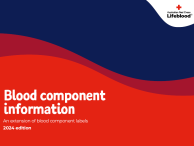Indications
Red cells are used for the treatment of clinically significant anaemia with symptomatic deficit of oxygen carrying capacity.
Red cell transfusion should not be dictated by a haemoglobin 'trigger' alone, but should be based on assessment of the patient’s clinical status. Many studies have found restrictive transfusion practice to be equal or superior to liberal transfusion practices.
Our prescribing red cells table provides guidance for transfusion based on the patient’s condition and haemoglobin level. It’s based on the National Blood Authority’s Patient Blood Management Guidelines.
The decision to transfuse red cells should be carefully considered, taking into account the full range of available therapies, and balancing the evidence for efficacy and improved clinical outcome against the potential risks.
Refer to the National Blood Authority Patient Blood Management Guidelines and other evidence-based clinical guidelines for specific guidance to support clinical decisions about appropriate transfusion practices and the use of blood components.
When should red cell transfusion be avoided?
The transfusion of red cells is not recommended for the treatment of anaemia associated with iron, vitamin B12 or folate deficiency if the patient’s clinical condition permits sufficient time for erythropoiesis following replacement. See Iron deficiency anaemia for more information.
Modifications
Red cells can be modified for specific indications and patient groups.
Dosage
The transfusion of a single unit of red cells followed by clinical reassessment to determine the need for further transfusion is considered best practice. A post-transfusion haemoglobin check is not mandatory but may be useful in some clinical situations.
The transfusion of a unit of red cells is expected to increase the haemoglobin of a 70 kg patient by approximately 10 g/L.
Transfuse ABO and RhD group identical red cells whenever possible.
However, the transfusion of Group O RhD negative red cells should be used in an emergency situation when the patient’s blood group is unknown. A blood sample should be taken for blood grouping prior to commencing transfusion to determine the patient’s blood group should ongoing transfusions be required.





